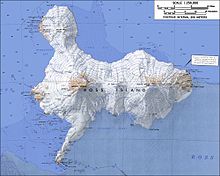| Mount Terra Nova | |
|---|---|
 c. 1922 panorama.
Hut Point Peninsula (foreground),
Mount Erebus (left),
Mount Terra Nova (center)
Mount Terror (right) | |
| Highest point | |
| Elevation | 2,130 m (6,990 ft) |
| Geography | |
| Geology | |
| Volcanic belt | McMurdo Volcanic Group |
Mount Terra Nova ( 77°31′S 167°57′E / 77.517°S 167.950°E) is a snow-covered mountain, 2,130 metres (6,990 ft) high, between Mount Erebus and Mount Terror on Ross Island in Antarctica. It was first mapped by the British National Antarctic Expedition (BrNAE) 1901–04, and named for the Terra Nova, relief ship for this expedition and the British Antarctic Expedition, 1910–13. [1]
Location
Mount Terra Nova lies between Mount Erebus to the west and Mount Terror to the east. It is south of Lewis Bay and north of Windless Bight. The Aurora Glacier and Terror Glacier drain its southern slopes. [2]
Geology
Mount Terra Nova is a dormant volcano. [3] It is in the Erebus province of the McMurdo Volcanic Group.[ citation needed] The blue-ice area at the summit has a diverse range of tephra. A 2014 study found seven layers: two phonolitic, one trachybasaltic, one trachytic, and two with a mixture of basanite, trachybasalt, phonolite, and trachyte glass shards. [4] Immediately below the summit there are outcrops of basalt, olivine basalt, and scoria. Most of the outcrops are covered in basalt, trachyte, and scoria glacial rubble. Lower down on the mountain there are some partially dissected vents and some flows of olivine basalt, basalt, scoria, and pyroclastics. [5]
Seismic activity
Between 1983 and 1984 a network of ten stations on Ross Island recorded 157 small earthquakes. An analysis of epicenters showed a linear pattern cutting across and beyond the island. Most of this activity was below Mount Terra Nova. The depths were from 0 to 25 kilometres (0 to 16 mi), with an average depth of 8.2 kilometres (5.1 mi). [6]
Features

Terror Saddle
77°31′00″S 168°05′00″E / 77.5166667°S 168.0833333°E. One of three prominent snow saddles on Ross Island, located about 1,600 metres (5,200 ft) high between Mount Terra Nova and Mount Terror. Named in association with Mount Terror, which rises to 3,262 metres (10,702 ft) high to the east of this saddle. [7]
Oamaru Peak
77°28′00″S 167°54′00″E / 77.4666667°S 167.9°E. A peak 2 nautical miles (3.7 km; 2.3 mi) north of Mount Terra Nova. The feature rises to about 1,000 metres (3,300 ft) high 1 nautical mile (1.9 km; 1.2 mi) north of Caldwell Peak. Named by New Zealand Geographic Board (NZGB) (2000) after Oamaru, Otago, New Zealand, the port the Terra Nova first visited after the death of Captain Robert F. Scott. [8]
Caldwell Peak
77°29′00″S 167°54′00″E / 77.4833333°S 167.9°E. A peak 2 nautical miles (3.7 km; 2.3 mi) north of Mount Terra Nova. The feature rises to about 1,300 metres (4,300 ft) high 1 nautical mile (1.9 km; 1.2 mi) south of Oamaru Peak. At the suggestion of P.R. Kyle, named by United States Advisory Committee on Antarctic Names (US-ACAN) (2000) after David A. Caldwell, geologist, New Mexico Institute of Mining and Technology, who worked two field seasons on Mount Erebus (first one, 1986-87); completed M.S. thesis on lava flows at the Mount Erebus summit. [9]
References
- ^ Alberts 1995, p. 739.
- ^ Ross Island USGS.
- ^ Hund 2014, p. 615.
- ^ Iverson et al. 2014, p. 4190.
- ^ Treves 1970, p. 103.
- ^ Rowe & Kienle 1986, p. 375.
- ^ Terror Saddle USGS.
- ^ Oamaru Peak USGS.
- ^ Caldwell Peak USGS.
Sources
- Alberts, Fred G., ed. (1995),
Geographic Names of the Antarctic (PDF) (2 ed.),
United States Board on Geographic Names, retrieved 2024-01-30
 This article incorporates
public domain material from websites or documents of the
United States Board on Geographic Names.
This article incorporates
public domain material from websites or documents of the
United States Board on Geographic Names. - "Caldwell Peak", Geographic Names Information System, United States Geological Survey, United States Department of the Interior
- Hund, Andrew J. (2014), Antarctica and the Arctic Circle: A Geographic Encyclopedia of the Earth's Polar Regions, Bloomsbury Publishing USA, retrieved 2024-02-04
- Iverson, Nels A.; Kyle, Philip R.; Dunbar, Nelia W.; McIntosh, William C.; Pearce, Nicholas J. G. (2014), "4.3.3 Mount Terra Nova", Eruptive history and magmatic stability of Erebus volcano, Antarctica: Insights from englacial tephra, doi: 10.1002/2014GC005435, retrieved 2024-02-04
- "Oamaru Peak", Geographic Names Information System, United States Geological Survey, United States Department of the Interior
- Ross Island, USGS: United States Geological Survey, retrieved 2024-01-30
- Rowe, C.A.; Kienle, J. (December 1986), "Seismicity in the vicinity of Ross Island, Antarctica", Journal of Geodynamics, 6 (1–4): 375–385, doi: 10.1016/0264-3707(86)90050-5
- "Terror Saddle", Geographic Names Information System, United States Geological Survey, United States Department of the Interior
- Treves, Samuel B. (1970), Volcanic Rocks of the Ross Island Area (PDF), retrieved 2024-02-04
![]() This article incorporates
public domain material from websites or documents of the
United States Geological Survey.
This article incorporates
public domain material from websites or documents of the
United States Geological Survey.
